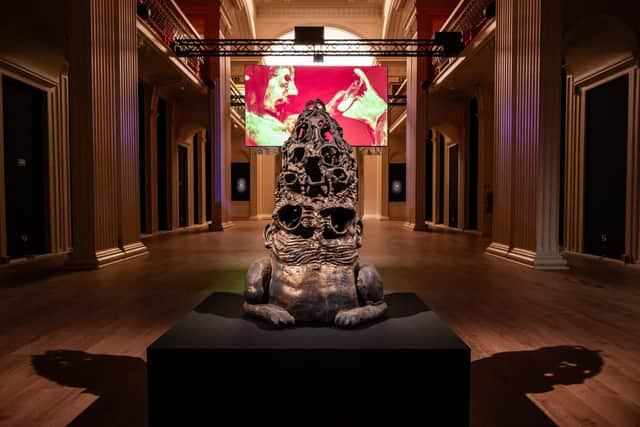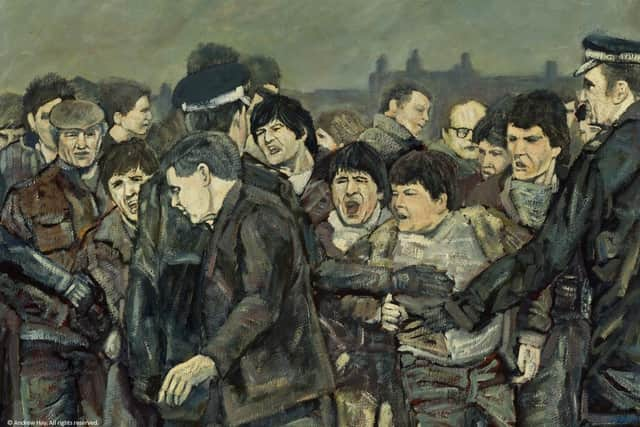Art reviews: Candice Lin | Talbot Rice Residents | Andrew Hay
Candice Lin: The Animal Husband, Talbot Rice Gallery, Edinburgh ***
Talbot Rice Residents, Talbot Rice Gallery, Edinburgh ***
Andrew Hay: Darkness on the Edge of Democracy, The Stirling Smith Gallery ****
Advertisement
Hide Ad

The relationship of human beings to the non-human is a recurring theme in contemporary art these days, both for itself and as a metaphor to talk about other subjects such as gender and race. But few artists do it quite as provocatively as Los Angeles-based Candice Lin is currently doing in Talbot Rice’s Georgian Gallery, once the university’s natural history museum.
Central to the show, physically and thematically, are two film monologues, The Animal Husband and The Blueness, both purportedly in the voices of cats, projected on a rotating screen. The first, from the perspective of Lin’s own cat, Roger, discusses castration, bestiality and the oddly sensual intimacy between cat and owner. The second cat is White’n’Gray, Roger’s feral uncle, whose perspective is wilder, more visceral. He is also something of a feline conspiracy theorist, speaking of a plague of alien-infested data-harvesting coyotes.
Included in the first film is the story of Thomas Granger, a teenager hanged in the early 17th century in what is now the US for bestiality. The law under which he was condemned is the same one which criminalised same-sex relationships, and was repealed in many states in more modern times. However, recent attempts to create another law to protect animals has fallen foul of the meat industry lobbyists.
The films feature a disorientating mix of imagery including what looks like both digital and stop-motion animation as well as illustrations and photographs from the university’s historic teaching collection. The rotating screen doesn’t add anything to the concept and makes the whole thing quite difficult to watch.
![Crystal Bennes: O (copper, cotton, cobalt, crude, naphtha, bauxite, palm), and Pecunia non olet [“money no smell”], 2024. PIC: Sally Jubb / courtesy of Talbot Rice Gallery, University of Edinburgh](https://www.scotsman.com/webimg/b25lY21zOjUwODcyNTlmLTc4NmEtNGEyZS1hMGU4LTBlYWE2MjJlY2Q3NTo3NGFlYzBiNy0yMzdkLTRjOWItOWIwNi1lMGU2NjYyZTNjOTQ=.jpg?crop=3:2,smart&width=640&quality=65)
![Crystal Bennes: O (copper, cotton, cobalt, crude, naphtha, bauxite, palm), and Pecunia non olet [“money no smell”], 2024. PIC: Sally Jubb / courtesy of Talbot Rice Gallery, University of Edinburgh](/img/placeholder.png)
The films are accompanied by ceramic sculptures, including Piss Protection Demon, a cat-human-wolf hybrid sprayed with wolf urine, and The Moon/Inside Out, a cast model of a uterus inside which a further film is projected (the viewer has to squat down and look through the vagina in order to see it). There are kites emblazoned with Feline Messages to the Human World, and smaller sculptures, some of which are attached to human-sized metal collars (these continue upstairs, where there are also drawings).
It’s wide-ranging but muddled, taking pot-shots indiscriminately at a range of issues: human exploitation of animals; the parallel exploitation by western medicine of women, queer people, the enslaved; the strange fetishisation of pets. Is Lin reminding us of what it means to encounter a truly animal perspective, or admonishing us for losing sight of the animal in ourselves? I left befuddled, though with an increased awareness of how strange and contradictory human attitudes towards animals really are.
Advertisement
Hide AdThe rest of the gallery is given over to the ten Talbot Rice Residents, the last two cohorts of the gallery’s scheme to support emerging artists under the Freelands Artist Programme.
A few years out of college, they are at radically different stages in their careers. Sekai Machache, for example, is already well known: her work here is taken from her outstanding show last summer at Mount Stuart and she is currently representing Zimbabwe at the Venice Biennale. Others are still honing their ideas and practice.
Advertisement
Hide Ad

Like Candice Lin, Renèe Helèna Browne is concerned with the relationship of the human and non-human with regard to dog training and celebrity “dog whisperer” Cesar Millan. While specific, Browne’s drawings also seem to carry metaphorical weight as part of an exploration of attitudes towards queer and trans people. Ross Fleming’s ambitious film, No Place Like Homme, explores queer culture through a lens of viruses and vampires, before metamorphosing into a satirical perfume commercial.
Alaya Ang’s impressive construction of rope, bamboo and hessian sacks speaks to the history of the Samsui women who migrated from China to Singapore and Malaysia in the 1920s and 1930s to do menial labour. Crystal Bennes’ research-based practice looks at how commodity traders take control of countries’ natural resources. Maria de Lima has made a film about a knowledge exchange event on Skye in 2022 which brought together Scots with indigenous and traditional people from the North of Brazil – who discover they have much in common.
Kirsty Russell’s large-scale hanging made from her grandparents’ velvet curtains is about the politics of care, though the connections between form and ideas are not always very readable. One of the most engaging bodies of work is by Emmie McLuskey, an A-Z of Movement devised as part of her long-term collaboration with choreographer Janice Parker. The series of alphabetical screenprints, arranged as one might a frieze in a classroom, is inventive and interesting and is to be developed into a children’s book.
The strongest work here needs little or no explanation. The audience makes the journey seamlessly from visual piece of work to understanding the concept. Not all of the artists have reached this point, but their commitment and ambition speaks well of them, and of the time and space the residency has afforded.
One could say the career of artist Andrew Hay began with the miner’s strike. As a shop steward in the Transport and General Workers Union, he helped to deliver food packages to mining communities, and thus he was inspired to paint. A series of ten paintings depicting the strike were bought by Glasgow’s People’s Palace, setting the self-taught artist on a new career path.
Hay was working on this exhibition for the Stirling Smith, revisiting the strike 40 years on, at the time of his death in January and it is being staged as planned at his request. His aim in this body of work is to show the political and economic background to the strike, to argue, as others have, that it was part of Margaret Thatcher’s “clandestine agenda to impose a new economic model”, the free-market system which has been widening the gap between rich and poor ever since.
Advertisement
Hide AdIt is difficult to make a detailed argument in a visual medium and Hay does employ a lot of text to make the necessary links between economists Friedrich von Hayek and Milton Friedman, the Pinochet regime in Chile and the Thatcher governments. However, there is no denying the power of some of his collages using photographs, newspaper headlines and other insignia, and The Shock Doctrines, angry paintings of wounded strikers being restrained by faceless police in riot gear.
Perhaps stronger still are works like Brutal Shadow (Chile 1973) and The Coming Solution, which have an allegorical power. Also highly effective are his more abstract pieces. Victory for miners is a palimpsest of fading graffiti, and assemblages made using coal, sacks and colour bring together his subject and his material as the best conceptual art can do.
Candice Lin and Talbot Rice Residents until 1 June; Andrew Hay until 30 June